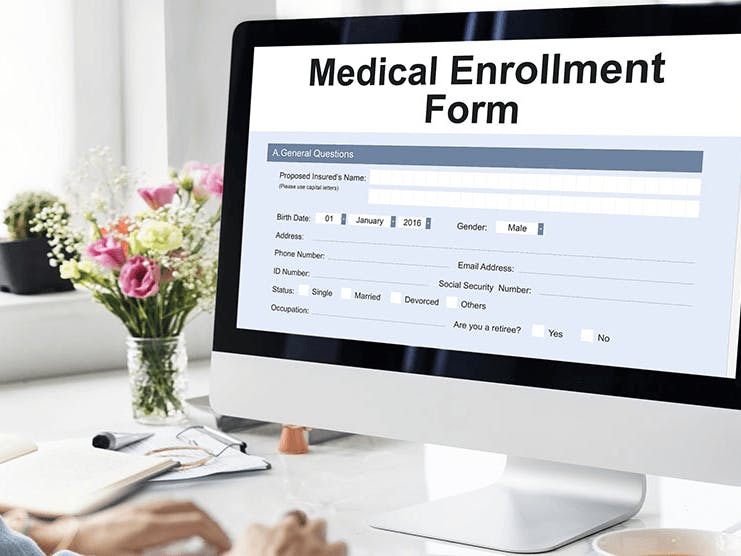
If you have Medicare Part A and are ready to add Part B, the process is a bit different than when you applied for Part A.
Although the Center for Medicare & Medicaid Services (CMS) manages the Medicare program, enrollment occurs through either the Social Security Administration (SSA) or Railroad Retirement Board (RRB).
How do you enroll in Medicare?
Most people enroll in Medicare through the Social Security Administration. The fastest, easiest way to do it is by completing the online application at SSA.gov. It's available 24 hours a day, 7 days a week, and takes less than 10 minutes to complete.
The online application allows you to sign up for both Medicare Part B and Medicare Part A. (If you already have Part A and are adding Part B during a Special Enrollment Period (SEP), please see the section How to Apply for Medicare Part B When You Already Have Part A below.)
If you prefer, you may also call Social Security at 1-800-772-1213 (TTY 1-800-325-0778). Representatives are available Monday through Friday from 7 AM until 7 PM.
In-person Medicare enrollment has been suspended since March of 2020, which is when local Social Security offices closed due to the COVID-19 pandemic. Once offices reopen, you may find your local SSA office by clicking here.
When applying for Medicare through Social Security, you need the following information:
- Date and place of birth
- Medicaid number (if applicable)
- Current health insurance information, including employment start and end dates and the start and end dates of your current coverage (if applicable)
Social Security provides this checklist to help you prepare for your Medicare and retirement applications.
The Railroad Retirement Board manages Medicare enrollment for anyone who worked for a railroad. Call the RRB toll-free at 1-877-772-5772 (TTY 1-312-751-4701) Monday through Friday from 9 AM until 3:30 PM.
Finally, if you have questions about your Medicare coverage or eligibility, call 1-800-MEDICARE (633-4227) or TTY 1-877-486-2048.
Who has to enroll in Medicare?
If you are not collecting RRB or Social Security benefits at least 4 months before your 65th birthday, you need to sign up for Medicare.
If you qualify for Medicare because you have end-stage renal disease (ESRD), had a kidney transplant, or require regular dialysis, you must manually sign up for Medicare.
Is anyone automatically enrolled in Medicare?
You are automatically enrolled in Medicare if you:
- Began collecting RRB or Social Security retirement benefits at least 4 months before turning 65
- Live outside the U.S., such as in Puerto Rico or the Virgin Islands, you'll be automatically enrolled in Part A but not Part B
- Received RRB or Social Security disability benefits for 24 months, you're automatically enrolled in month 25
- Were diagnosed with amyotrophic lateral sclerosis (ALS, more commonly known as Lou Gehrig's disease)
Medicare beneficiaries who qualify due to an ALS diagnosis are automatically enrolled in Medicare the same month their disability benefits begin.
How to apply for Medicare Part B when you already have Part A
Often, people who have health insurance through a group employer plan when they turn 65 sign up for premium-free Part A but delay enrollment in Part B until their current employment or coverage ends. This is one of the most common scenarios that qualifies for a Special Enrollment Period.
If you qualify for an SEP and already have Part A, signing up for Part B is a little different. You start by downloading the Application for Enrollment in Medicare – Part B (Medical Insurance), which is Form CMS-40B. If the reason for your application is a loss of group health coverage or employment, you also need to complete Form CMS-L564 – Request for Employment Information.
You have three options to submit your Medicare Part B enrollment request:
- Online at SSA.gov here, making sure you have your Medicare ID number, current address and phone number, valid email address, and documentation that verifies your group health coverage through either your or your spouse's employer
- Fax your completed forms – including employer signature – to 1-833-914-2016
- Mail your completed forms to your local Social Security office (find the address here)
If possible, your employer (or your spouse's) should complete Section B and sign Form CMS-L564. If this is not possible, you may complete Section B and submit at least one of the following:
- Income tax form detailing the health insurance premiums you paid
- A W-2 or pay stubs that show pretax contributions to medical insurance
- A health insurance card that includes the policy's effective start date
- An explanation of benefits from your group health plan (GHP) or local government health plan (LGHP)
- Invoice, statement, or receipts that show payments for your health insurance premiums
Your Part B coverage begins on the date you enter into Form CMS-40B. You may then choose to join a Part D prescription drug plan or Part C Medicare Advantage plan.
When should you sign up for Medicare?
The best time to sign up for Medicare is during your Initial Enrollment Period (IEP). This begins 3 months before your 65th birthday and ends 7 months later. So, if your birthday is February 4, your IEP begins on November 1 and ends May 31. However, if your birthday falls on the first day of the month, those dates move ahead one month (October 1 through April 30 if you turn 65 on February 1).
If you delay Part B enrollment because you have creditable coverage elsewhere, you'll qualify for a Special Enrollment Period. In this case, you may sign up for Part B at any point during your continued coverage/employment OR during the 8-month period following the end of your (or your spouse's) employment or the group health plan coverage said employment provided, whichever comes first.
What if you don't want Medicare Part B?
If you were retired when you turned 65 and automatically enrolled in Medicare Part B, you'll receive your red, white, and blue Medicare card 3 months before your 65th birthday. If you do not wish to keep Part B, just follow the instructions you received with the card and send it back. Failure to do so means you owe the Medicare Part B premium.
Beneficiaries who signed up for Part B through Social Security must contact SSA to drop their coverage. Call 1-800-772-1213 (TTY 1-800-325-0778).
What happens if you're late signing up for Medicare Part B?
If you delay Medicare Part B enrollment and do not qualify for an SEP, you may owe a late enrollment penalty, which is 10 percent of the monthly Part B premium for every 12-month period that you delayed signing up. So, 12 months equals 10 percent, 24 months equals 20 percent, and so on. You pay this penalty for the entire time you have Medicare.
There is also a late enrollment penalty for Part A, but around 99 percent of Medicare beneficiaries get premium-free Part A. However, if you or your spouse did not work and pay Medicare taxes for the required 10 years/40 quarters, you will owe a 10 percent late fee for twice the number of years you could have had Part A but did not. So, 12 months equals 2 years, 24 months equals 4 years, and so on.
If you don't sign up for Medicare during your IEP and you do not qualify for a Special Enrollment Period, you must wait for the General Enrollment Period (January 1 through March 31). You then have from April 1 through June 30 to join a Medicare Advantage or Part D prescription drug plan. Your Medicare coverage will begin July 1. Depending on when you qualified for Medicare, this start date may result in you owing the Medicare late enrollment fee.
How to join a Medicare Advantage or Part D plan
You may sign up for a Medicare Advantage or Part D prescription drug plan during your Initial Enrollment Period, if you qualify for an SEP, or during the General Enrollment Period after you sign up for Parts A and B.
If you're already enrolled in Original Medicare, you may sign up for an Advantage or Part D plan during the Annual Enrollment Period (AEP) that occurs every year from October 15 through December 7. Current Medicare Advantage beneficiaries may also participate in the Medicare Advantage Open Enrollment Period from January 1 through March 31. However, your only options then are switching to a different Advantage plan or returning to Original Medicare. If you lose your prescription drug coverage as a result of making that change, though, you may also join a standalone Part D plan.
Medicare Advantage and Part D plans are provided by private insurance companies. Comparing plan options is easy with our Find a Plan tool. Just enter your zip code to start reviewing Medicare plans in your area.
When is the best time to sign up for a Medigap plan?
If you decide to stay with Original Medicare instead of joining an Advantage plan, you should consider adding a Medicare Supplement Insurance plan. More commonly known as Medigap, these plans help pay your out-of-pocket Medicare costs. All of them cover the Part A deductible and give you an additional 365 lifetime reserve days for inpatient hospital care.
The best time to sign up for a Supplement plan is during your Medigap Open Enrollment Period (OEP). This 6-month period begins when you're both age 65 or older AND enrolled in Original Medicare. During your Medigap OEP, you cannot be denied coverage or charged more for your plan, even if you have a preexisting medical condition.
Additional resources
Medicare Part B Enrollment
External Website Link
Medicare Benefits
External Website Link
Social Security Office Locator
External Website Link
Checklist for Online Medicare, Retirement, & Spouses Applications
PDF Document-886 KB
Request for Employment Information (form CMS-L564)
PDF Document-88.0 KB
Application for Enrollment in Medicare Part B
External Website Link
When Can You Enroll in Medicare?
Internal Website Link



